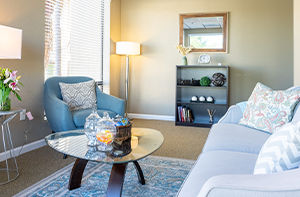
Anxiety Disorders
Anxiety disorder symptoms affect tens of millions of Americans, only about a third of whom will receive treatment for their conditions in any given year. The symptoms of anxiety disorders are intense, uncomfortable, and life-altering, and they affect daily functioning in numerous ways. Despite their pervasive nature, anxiety disorders are highly responsive to treatment, and when sufferers are committed to recovery they can learn to control their anxiety and minimize its effect on their lives.
Anxiety Disorder Definition
When men and women experience persistent and overwhelming anxiety that is out of proportion to any actual threat, they may be suffering from an anxiety disorder.
While normal anxiety is unpleasant but bearable, the more severe unease experienced by anxiety disorder sufferers prevents them from living freely and pursuing their interests without restriction. Certain encounters, events, or environments provoke strong feelings of distress and discomfort, and anxiety disorder sufferers will go to great lengths to avoid exposure to the people or places that trigger their anxious responses.
Anxiety disorders disrupt daily functioning. People who have them may struggle to find and keep jobs, perform well in school, build satisfying relationships, or practice activities that bring them pleasure or aid in their self-development.
Types of Anxiety Disorders
There are six types of anxiety disorders:
- Specific phobias. Phobias are intense, irrational, and uncontrollable fears of specific people, places, or things. Specific phobias as a group are the most common form of anxiety disorder, affecting 8.7 percent of the adult population.
- Social anxiety disorder. People with social anxiety disorder are overwhelmed by nervousness and excessive self-consciousness in a variety of social situations. Social anxiety disorder sufferers are afraid of being embarrassed or rejected, and while they desire to make connections with other people they are inhibited from doing so by their own insecurities. Social anxiety disorder affects 6.8 percent of the adult population, making it the second most commonly diagnosed form of anxiety disorder.
- Generalized anxiety disorder (GAD). People with generalized anxiety disorder are plagued by unfocused, non-specific fears, worries, and concerns. These emotions are often chronic and usually unconnected to any previous experiences. GAD sufferers fear disastrous outcomes in a variety of situations, despite no evidence to suggest they are likely. The symptoms of GAD are experienced by about 3.1 percent of the adult population.
- Panic disorder. Men and women with panic disorder experience sudden attacks of extreme anxiety, which produce a range of frightening and disabling symptoms, including dizziness, pounding heartbeat, heavy sweating, breathing difficulties, and an intense fear of fainting. Panic disorder affects about 2.7 percent of the adult population.
- Obsessive-compulsive disorder (OCD). Obsessive-compulsive disorder produces intrusive, unpleasant, recurrent thoughts, accompanied by repetitive rituals or behaviors that sufferers feel compelled to repeat to stave off catastrophe. The psychological obsessions and behavioral compulsions associated with OCD are unwelcome and irrational, but people with OCD don’t know how to control them. About one percent of the adult population suffers from the stressful symptoms of OCD.
Anxiety Disorder Facts and Statistics
Anxiety disorders touch virtually every family. But those who experience their anxiety disorder symptoms often suffer in silence, fearing that others will not understand their feelings or sympathize with their plight.
The truth about anxiety disorders is revealed in the numbers:
- Approximately 40 million Americans aged 18 and over will suffer from at least one anxiety disorder in any 12-month period. This represents 18.1 percent of the adult population.
- Of the 40 million American adults with anxiety disorders, 22.8 percent experience severe symptoms on a daily basis.
- In the adult population, the lifetime prevalence of anxiety disorders in the United States is 28.8 percent.
- Lifetime incidence rates are highest among those in the 30-44 age group, where 35.1 percent report symptoms consistent with an anxiety disorder.
- Anxiety disorders are usually diagnosed in adults, but the earliest anxiety disorder symptoms are normally experienced in childhood. The average age of onset for an anxiety disorder is just 11 years old.
- Women comprise about 60 percent of all anxiety disorder sufferers, although the ratios between men and women differ between specific disorders.
- In any given year, only 36.9 percent of people with anxiety disorders will receive treatment for their conditions.
Anxiety Disorder Symptoms and Diagnosis
The situations that trigger an anxious reaction differ based on anxiety disorder type. But all anxiety disorders produce physical symptoms consistent with severe and uncontrollable anxiety, including:
- Rapid heartbeat
- Heavy sweating
- Dizziness or vertigo
- Respiratory difficulties
- Numbness or tingling in the hands or face
- Muscle tension and pain
- Stomach aches, nausea, diarrhea
- Shaking, trembling
- Dry mouth and difficulty speaking
- Brain fog (an inability to think clearly or react quickly)
Individuals with anxiety disorders try to avoid any experience or environment they believe will initiate an anxious response. When they know exposure to such situations is unavoidable, they often suffer severe anticipatory anxiety beforehand, which only deepens the suffering associated with their condition.
Diagnosing an Anxiety Disorder
Following an extensive interview and evaluation, a mental health professional will diagnose an anxiety disorder if multiple anxiety symptoms are reported. Some of these symptoms may be general in nature, while others are consistent with a particular disorder. These signs of anxiety must have been on display for six months or more, and they must have been severe enough to disrupt normal functioning.
Before consulting with a psychiatrist or psychologist, patients who suspect they have an anxiety disorder should first schedule an appointment with a physician for a full medical checkup. This is necessary to make sure no illness or underlying physical condition is causing symptoms that mimic anxiety.
Causes and Risk Factors
Anxiety disorders are linked to multiple risk factors, which include:
- Genetics/family history. Having one or more parents who were diagnosed with an anxiety disorder or clinical depression (or both) substantially increases the odds of an anxiety disorder developing.
- Gender. Women are diagnosed with anxiety disorders more often than men, by a ratio of approximately three-to-two.
- Disturbed family environment. Children exposed to interfamilial conflict, divorce, parental neglect or abandonment, and physical, mental, or verbal abuse are more likely to suffer from anxiety disorders in adulthood.
- Exposure to childhood sexual abuse. This type of abuse significantly increases the risk for all types of mental illness, not just anxiety disorders.
- Low self-esteem. Self-esteem issues are implicated in the onset of anxiety disorders, and once they develop anxiety disorders damage self-esteem even further.
- Exposure to trauma before the age of 21. Exposure to repeated trauma in childhood or adolescence is especially prevalent among those diagnosed with PTSD, panic disorder, or specific phobias.
Anxiety disorders can seldom be traced to a single cause, but instead emerge from a combination of factors.
Co-Occurring Disorders or Complications
Clinical depression is the most frequently diagnosed co-occurring condition among those who suffer from anxiety disorders, with a lifetime incidence rate of up to 60 percent. This is not a coincidence: depression and anxiety both arise from overactive stress response systems and both provoke overstimulation of the brain’s emotional centers, which explains why both conditions respond to the same medications.
Bipolar disorder is another condition strongly associated with anxiety disorders. At least one-fourth (and probably more) of bipolar sufferers have co-occurring anxiety disorders, with PTSD, OCD, panic disorder, and social anxiety disorder all frequently diagnosed.
Eating disorders like bulimia and anorexia frequently develop in conjunction with anxiety disorders. In one study, women with eating disorders suffered from a co-occurring anxiety disorder 65 percent of the time, and in 69 percent of these instances it was the anxiety disorder that manifested first.
Like other people with mental health problems, men and women with anxiety disorders face an elevated risk for drug and alcohol addiction. About 20 percent of anxiety disorder sufferers will struggle with substance abuse at some time in their lives, and likewise about 20 percent of people diagnosed with chemical dependency will suffer from a co-occurring anxiety disorder.
Anxiety disorder sufferers face an increased risk for other mental and behavioral health disorders, but severe anxiety is also implicated in the development of several serious physical health conditions, including:
- Migraine headaches
- Insomnia
- Diabetes
- Respiratory disease
- High blood pressure
- Irritable bowel system (IBS)
- Weakened immune functioning and vulnerability to viral illness
- Heart disease
- Cancer
Chronic stress and anxiety take a heavy toll on the human body, and if anxiety disorders are left untreated multiple health problems will inevitably develop.
Anxiety Disorder Treatment and Prognosis
Anxiety disorders respond well to treatment, and most people who seek help for their anxiety experience significant improvement in their symptoms over time.
Comprehensive treatment plans for severe anxiety have two core elements: psychotherapy and medication.
Psychotherapy. One-on-one therapy is an early focus, and eventually group therapy sessions will be added to the mix to help anxiety disorder sufferers connect with others on the same path to wellness. Therapies for anxiety disorders tend to have a strong practical orientation, and cognitive-behavioral therapy (CBT) has been shown to be especially effective against the symptoms of severe anxiety.
Medication. Many medications have been used to successfully treat anxiety symptoms. Various types of antidepressants have been found to relieve the symptoms of anxiety, including drugs from the SSRI, SNRI, MAOI, and tricyclic categories. Benzodiazepines are an anti-anxiety drug often given to anxiety disorder patients, but they can be addictive and are therefore appropriate only for short-term relief.
While most long-term treatment for anxiety takes place on an outpatient basis, men and women with anxiety disorders have a better chance of overcoming their disabling symptoms if they begin their recovery in a residential mental health facility. Inpatient care programs allow anxiety disorder sufferers to concentrate completely on the healing process, in a peaceful, supportive environment where staff and peers alike are focused on the same achievable goal—freedom from the disabling effects of chronic anxiety.
Why Choose BrightQuest for Anxiety Disorder Treatment?
We understand that one of the toughest decisions you can face is choosing the right treatment program for the one you love. We’ve taken this journey countless times with other families who’ve come through our doors with the same questions. There are several components that make the unique BrightQuest model so successful.
- Admissions Process and Comprehensive Assessment. We provide robust in-depth assessments into our admissions process to ensure accurate diagnoses and most appropriate level of care.
- We Treat the Family. We engage the entire family in treatment so that they can become more successful in navigating life with a loved one experiencing anxiety disorder.
- Inclusive Therapeutic Community and Levels of Care. We provide clients appropriate structure, supervision, and support as they progress through treatment in a safe environment that fosters responsibility, accountability, and social connectedness.
- Lasting Behavioral Change. We offer clients the tools, skills, and support necessary to attain greater stability and independence with the confidence and courage to live a healthy, happy, and productive life.
If you or a loved one is suffering from anxiety disorder symptoms, please contact us or learn more about our treatment program.






